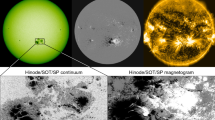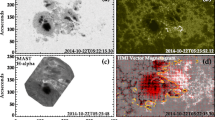Abstract
Abstract round-the-clock solar observations with full-disk coverage of vector magnetograms and multi-wavelength images demonstrate that solar active regions (ARs) are ultimately connected with magnetic field. Often two or more ARs are clustered, creating a favorable magnetic environment for the onset of coronal mass ejections (CMEs). In this work, we describe a new type of magnetic complex: cluster of solar ARs. An AR cluster is referred to as the close connection of two or more ARs which are located in nearly the same latitude and a narrow span of longitude. We illustrate three examples of AR clusters, each of which has two ARs connected and formed a common dome of magnetic flux system. They are clusters of NOAA (i.e., National Oceanic and Atmospheric Administration) ARs 11226 & 11227, 11429 & 11430, and 11525 & 11524. In these AR clusters, CME initiations were often tied to the instability of the magnetic structures connecting two partner ARs, in the form of inter-connecting loops and/or channeling filaments between the two ARs. We show the evidence that, at least, some of the flare/CMEs in an AR cluster are not a phenomenon of a single AR, but the result of magnetic interaction in the whole AR cluster. The observations shed new light on understanding the mechanism(s) of solar activity. Instead of the simple bipolar topology as suggested by the so-called standard flare model, a multi-bipolar magnetic topology is more common to host the violent solar activity in solar atmosphere.
Similar content being viewed by others
References
Wang J X, Zhou G P, Wen Y Y, et al. Transequatorial filament eruption and its link to a coronal mass ejection. Chin J Astron Astrophys, 2006, 6: 247–259
Wang J X, Zhang Y Z, Zhou G P, et al. Solar trans-equatorial activity. Solar Phys, 2007, 244: 75–94
Zhang Y Z, Wang J X, Attrill G D R, et al. Coronal magnetic connectivity and EUV dimmings. Solar Phys, 2007, 241: 329–349
Zhou G P, Wang J X, Wang Y M, et al. Quasi-simultaneous flux emergence in the events of October November 2003. Solar Phys, 2007, 244: 13–24
Schrijver C J, Title A M. Long-range magnetic couplings between solar flares and coronal mass ejections observed by SDO and STEREO. J Geophys Res, 2011, 116: A04108
Schrijver C J, Title A M, Yeates A R, et al. Pathways of large-scale magnetic couplings between solar coronal events. Astrophys J, 2013, 773: 93
Pesnell W D, Thompson B J, Chamberlin P C. The solar dynamics observatory (SDO). Solar Phys, 2012, 275: 3–15
Woods T N, Hock R, Eparvier F, et al. New solar extreme-ultraviolet irradiance observations during flares. Astrophys J, 2011, 739: 59
Woods T N. Extreme ultraviolet late-phase flares: Before and during the Solar Dynamics Observatory Mission. Solar Phys, 2014, 289: 3391–3401
Lemen J R, Title A M, Akin D J, et al. The atmospheric imaging assembly (AIA) on the solar dynamics observatory (SDO). Solar Phys, 2012, 275: 17–40
Wang J X, Jiang J. Magnetohydrodynamic process in solar activity. Theor Appl Mech Lett, 2014, 4: 052001
Zhang Y Z, Hu Y Q, Wang J X. Double catastrophe of coronal flux rope in quadrupolar magnetic field. Astrophys J, 2005, 626: 1096–1101
Zhang Y Z, Wang J X, Hu Y Q. Two-current-sheet reconnection model of interdependent flare and coronal mass ejection. Astrophys J, 2006, 641: 572–576
Zhang Y Z, Wang J X. A catastrophic flux rope in a quadrupole magnetic field for coronal mass ejections. Astrophys J, 2007, 663: 592–597
Longcope D W, Forbes T G. Breakout and tether-cutting eruption models are both catastrophic (sometimes). Solar Phys, 2014, 289: 2091–2122
Kliem B, Lin J, Forbes T G, et al. Catastrophe versus instability for the eruption of a toroidal solar magnetic flux rope. Astrophys J, 2014, 789: 46
Yan Y H, Sakurai T. New boundary integral equation representation for finite energy force-free magnetic fields in open space above the Sun. Solar Phys, 2000, 195: 89–109
He H, Wang H N, Yan Y H. Nonlinear force-free field extrapolation of the coronal magnetic field using the data obtained by the Hinode satellite. J Geophys Res, 2011, 116: A01101
Zhang J, Wang J X, Deng Y Y, et al. Magnetic flux cancellation associated with the major solar event on 2000 July 14. Astrophys J, 2001, 548: L99–L102
Wang J X, Zhou G P, Zhang J. Helicity patterns of coronal mass ejection-associated active regions. Astrophys J, 2004, 615: 1021–1028
Wang J X, Zhao M, Zhou G. Magnetic changes in the course of the X7.1 solar flare on 2005 January 20. Astrophys J, 2009, 690: 862–874
Wen Y Y, Wang J X, Maia D J F, et al. Spatial and temporal scales of coronal magnetic restructuring in the development of coronal mass ejections. Solar Phys, 2006, 239: 257–276
Zhang Y, Zhang M, Zhang H Q. A statistical study on the relationship between surface field variation and CME initiation. Adv Space Res, 2007, 39: 1762–1766
Chen A Q, Wang J X, Li J W, et al. Statistical properties of superactive regions during solar cycles 19–23. Astron Astrophys, 2011, 534: A47
Chen A Q, Wang J X. Quantifying solar superactive regions with vector magnetic field observations. Astron Astrophys, 2012, 543: A49
Nitta N V, Liu Y, DeRosa M L, et al. What are special about groundlevel events? flares, CMEs, active regions and magnetic field connection. Space Sci Rev, 2012, 171: 61–83
Vemareddy P, Ambastha A, Maurya R A, et al. On the injection of helicity by the shearing motion of fluxes in relation to flares and coronal mass ejections. Astrophys J, 2012, 761: 86–103
Grechnev V V, Uralov A M, Slemzin V A, et al. A challenging solar eruptive event of 18 November 2003 and the causes of the 20 November geomagnetic superstorm. I. unusual history of an eruptive filament. Solar Phys, 2014, 289: 289–318
Wang J X, Ji H S. Recent advances in solar storm studies in China. Sci China-Earth Sci, 2013, 56: 1091–1117
Low B C. Field topologies in ideal and near-ideal magnetohydrodynamics and vortex dynamics. Sci China-Phys Mech Astron, 2015, 58: 015201
Bumba V, Howard R. Large-scale distribution of solar magnetic fields. Astrophys J, 1965, 141: 1502–1512
Gaizauskas V, Harvey K L, Harvey J W, et al. Large-scale patterns formed by solar active regions during the ascending phase of cycle 21. Astrophys J, 1983, 265: 1056–1065
Author information
Authors and Affiliations
Corresponding author
Rights and permissions
About this article
Cite this article
Wang, J., Zhang, Y., He, H. et al. Cluster of solar active regions and onset of coronal mass ejections. Sci. China Phys. Mech. Astron. 58, 599601 (2015). https://doi.org/10.1007/s11433-015-5682-7
Received:
Accepted:
Published:
DOI: https://doi.org/10.1007/s11433-015-5682-7




